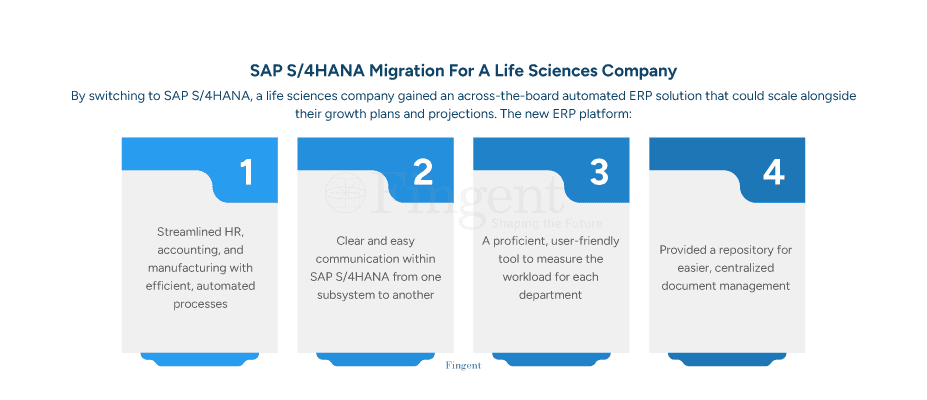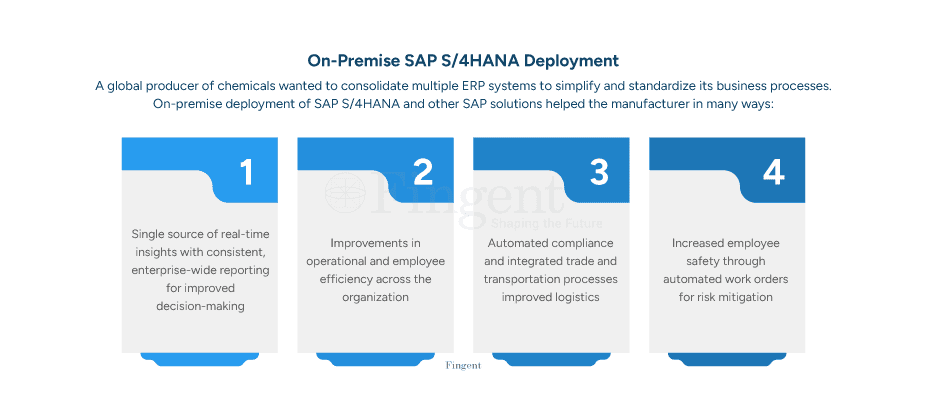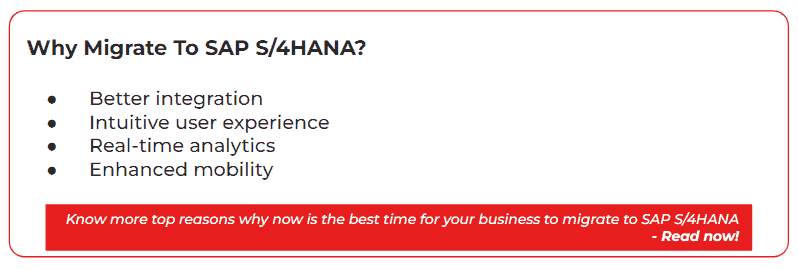Category: SAP
The ERP landscape continues to evolve rapidly, and SAP S/4HANA is now the prime focus. With more than 400,000 organizations currently using SAP ERP systems worldwide, these systems are known for speeding up and improving core business processes. However, as with everything, it is important to conduct a Cost-Benefit Analysis of SAP S/4HANA migration. This article helps you get started on that.
Strategize A Smooth SAP S/4HANA Migration Journey Get Accurate Estimates, Migration Approach & More!
The Push to Upgrade: Why it Matters?
While SAP’s legacy systems served reliably for many years, they quickly became considerable barriers to growth and innovation. Migration to SAP S/4HANA provides obvious benefits, from real-time data processing to seamless integrations with advanced technologies like AI and IoT, which are key elements often left in the shadow when considering competitiveness. This transition, if delayed further, could lead to missing such integrations and make it far more challenging to catch up in a setting that supports agility. It is here that the significant stakes are factored into the equation, and thus, the Cost Benefits of SAP S/4HANA start manifesting in detail.
A 2021 study by IDC on infrastructure adoption trends for SAP HANA and S/4HANA revealed that over 50% of North American firms with investments in SAP applications view these environments as crucial to their operations. Another third acknowledged their significant impact, while a striking 8% admitted that without SAP, their business would be at risk of failure. This highlights that companies investing in SAP’s suite of ERP solutions are surviving and thriving by leveraging these systems to maintain stability and competitive advantage.
Why Migrate to SAP S/4HANA?
Research has shown that more than 85% of Fortune 500 companies rely on the solution provided by SAP.
There’s a reason why. Here are some of them:
1. Real-Time Insights and Decision-Making
With SAP S/4HANA, the design caters to real-time data processing needs for swift, informed decision-making—facilitating strategic pivoting and operational improvement.
2. Streamlined Operations
SAP S/4HANA simplifies complex workflows. Unlike legacy systems with cumbersome data structures that slow processes, S/4HANA’s lean architecture ensures faster processing with minimal data redundancies, saving time and resources.
Did you know: Over the past five years, SAP clients have enjoyed a 15% cut in IT costs—proof that investing in smarter tech isn’t just a power move; it’s a wallet-friendly one.
3 . Enhanced User Experience
SAP Fiori, the contemporary interface of S/4HANA, is easy to navigate and includes interactive dashboards, simplifying training and increasing productivity. This plays a crucial role in the Cost-Benefit Analysis of SAP S/4HANA migration.
Did you know: Businesses experienced around 20% hike in operational efficiency after moving to SAP S/4HANA.
How Much Does it Cost to Migrate to SAP S/4HANA?
The important question is: what does SAP S/4HANA migration cost? Investments range from $250,000 to several million dollars for large organizations, covering software, consulting, training, and potential downtime. While initial costs may seem high, this investment is like choosing a high-speed train over continuous repairs to an old scooter. The Cost-Benefit Analysis of SAP shows that these investments pave the way for substantial long-term benefits, like reduced operational inefficiencies and enhanced data capabilities.
However, delaying migration can prove more costly in the long run. According to HFS Research, extended reliance on outdated systems may compound expenses as legacy technology maintenance costs climb. Conducting a thorough cost-benefit analysis of SAP migration ensures that these expenditures are justified and strategic.
Types of Migration Approaches and Cost-Benefit Impact
Choosing the right migration approach can feel like deciding between a road trip and a direct flight—it’s all about speed, cost, and comfort. There are generally three main approaches:
Greenfield Implementation: This “clean slate” strategy involves starting fresh with SAP S/4HANA. It’s the most comprehensive but also the most expensive approach. The Cost Benefits of SAP here lie in having a fully optimized and customized system minus legacy baggage.
Brownfield Migration: Think of this as renovating your old house. You upgrade to SAP S/4HANA but keep your existing structure. This is a middle-ground approach. It balances costs and benefits by enabling quicker transition.
Hybrid Approach: A blend of greenfield and brownfield strategies, where certain system parts are revamped while others are preserved. This method allows for incremental improvements without blowing the budget. In a thorough Cost-Benefit Analysis of SAP, hybrid models often show flexible results tailored to specific business needs.
Risks and Challenges of SAP S/4HANA Migration
Migrating to SAP S/4HANA isn’t all sunshine – it comes with its fair share of risks. One big challenge is potential business downtime, which could impact operations and revenue. Then there’s data migration complexity—think of moving your digital mansion without losing your prized data heirlooms. Proper planning and employing skilled SAP consultants mitigate these risks and add to the Cost Benefits of SAP by preventing costly mistakes.
Another often overlooked risk is change management. Employees comfortable with legacy systems may resist the new kid on the block. Here’s where a well-orchestrated training plan and strong leadership are pivotal in the Cost-Benefit Analysis of SAP S/4HANA migration.
Choose An SAP S/4HANA Migration Approach That Suits Your Business
Real-World Examples
Companies that have leaped SAP S/4HANA often see ROI in unexpected ways. Here are the results from a study conducted by Forrester:
Increased Revenue: Companies saw a revenue increase of $156 million (+5.8%) over three years due to new capabilities enabled by SAP S/4HANA, including new business offerings. A significant 37% of respondents experienced a 3.2% average revenue increase.
Customer Retention: SAP S/4HANA’s transparency and improved processes reduced customer churn by 4.1%, valued at $8.4 million. This contributed to better customer relationships and Net Promoter Scores.
End-User Productivity: Reduced run times led to $2.1 million in productivity gains for business employees, with 53% of respondents seeing reduced run times. This saved 100 minutes per week per employee, with 50% of that time being redirected to other tasks.
Avoided Costs: Companies saved $524,042 in avoided software and hardware costs, retiring $200,000 in licenses by year two and an additional $400,000 by year three. This savings began in the second year after migration.
IT Organization Productivity: SAP S/4HANA migration led to a productivity boost worth $442,971 for IT staff, with 62% of companies seeing a 5% gain in employee efficiency. This improvement freed up time for more strategic tasks.
Accelerated Cash Flow: Simplified order processes sped up customer shipments from 14 months to just two, resulting in an additional $2.6 million in revenue. Quicker customer payments drove faster cash flow.
Improved Collections: Simplified accounting processes reduced outstanding accounts receivable days from 117 to 101, saving $1.1 million. Faster invoicing and fewer errors contributed to these improvements.
SAP S/4HANA Migration Use Cases & Real Life Examples
Key Considerations for a Successful Cost-Benefit Analysis and How Fingent can Help
The Cost-Benefit Analysis of SAP migration underscores one crucial point: it’s an investment in future-proofing your business. To make the transition successful, consider aligning your business objectives, choosing the appropriate migration path, and preparing for potential challenges. Fingent can assist you in every phase of this process, offering knowledge to reduce risks and enhance the cost benefits of SAP. Whether you opt for greenfield, brownfield, or hybrid projects, Fingent’s assistance allows your business to transition confidently and effectively.
Connect with our experts and strategize your SAP S/4HANA Migration journey today!
Stay up to date on what's new

Featured Blogs
Stay up to date on
what's new



Talk To Our Experts
Is your business stuck in the Stone Age with outdated systems, hobbling along like a dinosaur on roller skates? Migration to SAP S/4HANA is just the thing you need. Companies making the jump report a jaw-dropping 30% boost in performance within just a year.
There is also the fact that it might not be a choice anymore. By 2027, SAP is pulling the plug on ECC support. This is a blessing in disguise because the benefits that SAP S/4HANA can bring to your business are manifold. In this article, we discuss how this migration impacts your IT teams.
Future-proof Your Business With SAP S/4HANA Migration Our Experts Can Ease Your Transitions With Best Practices & Implementation Process
Why Should You Choose Migration to SAP S/4HANA?
You wouldn’t wear flip-flops for a marathon, would you? Using outdated systems in the current business landscape is the same thing. It hinders your advancement. SAP S/4HANA is the necessary upgrade to outpace all competitors. S/4HANA migration is a much-needed turbo boost for your business.
What does it mean practically?
SAP S/4HANA offers you real-time data. It’s like driving with GPS rather than a paper map. Additionally, S/4HANA gives your business the capability to scale up when needed. If your company expands slowly or undergoes a sudden surge, SAP S/4HANA can adapt accordingly. It’s a financial commitment that guarantees flexibility and effectiveness in a world prioritizing digital technology.
What is the Difference Between S4HANA Conversion and Migration?
Think of it this way: converting is like spicing up your old house with a fancy renovation, while migrating is like starting fresh with a brand-new build. You are giving your existing SAP ERP system a sleek makeover with SAP S/4HANA, keeping the core intact but upgrading the features. This process is usually best suited for businesses already using an older SAP system (ECC) but want to switch to the faster, more efficient S/4HANA without losing existing configurations.
On the other hand, migration goes beyond simple conversion. Migration to SAP S/4HANA is like moving to a new house designed with modern architecture, better efficiency, and advanced features. This process often requires re-engineering business processes and involves data transformation. Here’s where your company gets an opportunity to take a reality check. For instance, during migration, you could redesign outdated processes or clean up old, irrelevant data—think of it as an opportunity to declutter and start fresh.
While more complex than conversion, S4HANA migration offers flexibility. Another often overlooked difference is the impact on user experience. While conversion ensures continuity for existing users (familiar workflows with enhanced features), migration often means retraining staff on entirely new processes and interfaces.
What are the Benefits of Migrating to S/4HANA?
In an era where data surges like a wave, choosing to ride it is not just beneficial; it’s a necessity. The World Economic Forum projects a seismic shift—daily data creation will surge to 463 exabytes by 2025. To put that in perspective, imagine over 212 million DVDs filled with data daily. Positioning yourself at the forefront of this digital tsunami requires a robust platform. Enter migration to SAP S/4HANA—a beacon of excellence in a sea of data.
Here are some key advantages of embracing SAP S/4HANA migration:
- Predictive intelligence breeds opportunity: Embedded within are the threads of foresight and analytics that not only illuminate the present but also predict the future. This ensures that you outmaneuver every market fluctuation.
- Boundless growth with matchless scalability: Start small, dream big. Today’s boutique venture is tomorrow’s global empire. S/4HANA’s adaptable skeleton is designed to evolve with your ambitions.
- The gift of now with real-time data: Harness the lightning. S/4HANA’s in-memory computing prowess offers instant revelations, empowering snap decisions woven with wisdom.
- A speed like no other: Bid farewell to lethargic data trawls. Embrace the swift grace of in-memory computing to elevate the pace at which data bows to your command.
- Symphony with simplified IT: The S/4HANA migration transmutes a web of systems into a symphony, slicing through complexity and carving a path to reduced IT expenses.
- An interface that understands you: Through the lens of SAP Fiori, interactions bloom into simplicity and create an enhanced user experience. This ignites productivity and casts aside the shadows of error.
- Performance that dazzles with peak system functionality: Those who pledge allegiance to S/4HANA migration gain swift passage to expedited financial closures and the nimble agility needed to keep pace with the market’s real-time heartbeat.
- Future-proof Infrastructure: S/4HANA is not merely a platform; it is a portal to tomorrow. Those aboard are set to embrace the coming waves of AI and machine learning, poised to ride the crest of innovation.
Embarking on an S/4HANA migration equips you with the orb of strategic clairvoyance, the spear of scalability, and the shield of performance in the battle for business supremacy.
What Businesses Need To Know Before S/4HANA Migration:Use Cases & Examples
The Blueprint to S/4HANA Migration
The Genesis Approach: New Implementation
The New Implementation strategy champions adopting industry best practices, fostering a streamlined core that thrives on agility. While it extends unparalleled flexibility, the complexities it entails are linked to the existing technological ecosystem.
The Evolutionary Leap: System Conversion
System Conversion offers a metamorphic transition that preserves the essence of an organization’s existing SAP ERP system, such as ECC. It is a cost-effective move that transmutes the old into the cutting-edge S/4HANA without the toil of starting anew. The treasure trove of data and processes is retained. However, this strategy is not without its challenges. Businesses must navigate the altered landscapes of S/4HANA’s architecture, embracing innovations like the Universal Journal that streamline financial narration.
The Integrative Mosaic: Landscape Transformation
When confronted with the complexity of multiple ERP systems strewn across diverse locales and operational sectors, Landscape Transformation takes center stage. This approach weaves disparate systems into an integrated S/4HANA into one, yielding a cohesive operational vista.
Each strategy depends on business-specific imperatives. The right migration strategy to SAP S/4HANA can catalyze business value, ensuring operational harmony and technological resilience.
SAP S/4HANA Migration with Fingent – Swift and Smooth
At Fingent, we understand the importance of migration to SAP S/4HANA in safeguarding your business for the future. Our customized method ensures a smooth changeover, whether you opt for a new installation, system migration, or landscape alteration. We thoroughly evaluate your existing systems to suggest the most effective strategy.
With Fingent, you can count on comprehensive support from start to finish, guaranteeing minimal interruption and zero data loss. Our tailor-made solutions enhance the capabilities of SAP S/4HANA, offering your business advanced analytics and real-time data processing. Our effective methods and training sessions give your team the necessary skills to succeed.
Don’t simply adjust—excel! Collaborate with Fingent to leverage the importance of SAP S/4HANA migration and achieve a competitive advantage in the current market. Let’s start this transformative journey as a team!
Stay up to date on what's new

Featured Blogs
Stay up to date on
what's new



Talk To Our Experts
Organizations relying on SAP are facing a crucial choice. Should we migrate to SAP S/4HANA, and if so, when? SAP’s decision to end support for ECC in 2027 is the primary reason that pushes the necessity to migrate. Beyond the fast-approaching deadline, the transition offers businesses numerous opportunities to unlock innovation. Wondering how your industry peers are enjoying a smooth transition to S/4HANA? Why not take a few minutes to explore some real-world SAP S/4HANA migration use cases? In this blog, we discuss how several businesses are reaping the benefits of the next-gen ERP.
Migrate Smoothly To SAP S/4HANA Without Business Disruptions.
Why is SAP S/4HANA Migration Crucial Now Than Ever?
Here are a few factors that drive the urgency to migrate to S/4HANA:
1. End of Support for ECC
SAP is ending its official support and maintenance for ECC by 2027. That leaves existing SAP users with no second choice but to migrate to SAP S/4HANA.
2. Real-Time Analytics
AI, ML, predictive analytics, and in-memory computing in SAP S/4HANA empower organizations to unlock the true potential of their data. Data-driven insights and decisions foster innovation and growth.
3. Enhanced User Experience
S/4HANA offers a modern, sleek, and intuitive user interface. The accessible, user-friendly UI helps drive employee productivity and user experience.
4. Process Optimization
From data to supply chain management, S/4HANA provides all the support that a business needs in a simple, intuitive package. It helps reduce complexity and increase efficiency across the organization.
5. Improved Integrations
S/4HANA helps integrate complex IT systems without letting companies worry about the technical aspects. That way, companies can focus on growth and expansion. Enhanced integrations allow you to track and analyze data from multiple systems in one place.
How Does Migrating to SAP S/4HANA Benefit Your Business?
Transitioning from ECC to S/4HANA is a promising upgrade for your organization. Here is how SAP S/4 HANA migration benefits your business:
1. Fast and Efficient Decision-Making
S/4 HANA relies on SAP’s own in-memory database, called SAP HANA. It speeds up data processing and analysis, providing companies access to real-time insights. This enables informed decisions that will ultimately increase productivity and competitiveness.
2. Enhanced Scalability and Flexibility
S/4 HANA is designed with cloud integration in mind. Cloud capabilities can supercharge business operations with added scalability and flexibility. It allows organizations to accommodate changing business needs.
3. Intelligent Business Operations
Advanced technologies in S/4HANA, such as AI, ML, and RPA support automated and standardized business operations. Automating routine processes will free your employees so they can focus on value-adding tasks.
4. Limited Data Errors
S/4HANA’s simplified data model eliminates data duplication and common errors. It also reduces the need for constant data reconciliation.
5. Integrated, End-to-End Solution
SAP S/4HANA serves as an integrated, end-to-end business solution. Every component of the ERP syncs and works together, offering your business a single source of truth.
SAP S/4HANA Migration Use Cases
How does SAP S/4HANA drive business transformation across various verticals? Here are three SAP S/4HANA Use Cases:
1. Banking
Organization: A global real estate investment banking services provider
Challenges faced by the bank:
- Legacy IT system loaded with unnecessary data and functions
- Complex IT architecture limiting system performance
Solution:
- Switch to a new high-performance, future-proof core banking system on SAP S/4HANA.
Benefits:
- An integrated solutions portfolio to support the digitalization of processes, including back-end systems
- Standardized the interfaces between systems for more flexibility based on individual components
- Unlocked growth potential with new business models and digitized processes
2. Telecom
Organization: A a leading digital/tele-communications service provider in the APAC region
Challenges faced by the telecom company:
- Legacy systems that couldn’t support evolving business needs in a fast-paced market environment
- Time-consuming monthly management reporting processes
- Fragmented processes that resulted in business inefficiencies
- Poor insights, delayed and wrong decisions, and substandard user experiences
Solution:
- Migrate to SAP S/4HANA to optimize operations, improve user experiences, and gain a competitive edge.
Benefits:
- Enabled finance transformation by establishing a single source of truth
- Faster financial transaction processing and books closing, along with error-free reporting
- Strengthened IT security with improved authorization controls and compliance.
3. Consumer Products
Organization: A leading distributor of products for self-service stores
Challenges faced by the company:
- Decentralized information, leading to data loss and duplication
- Manual processes used for unit conversion
- Lack of security and consistency caused by complex data-entry processes
Solution:
- Manage key logistics processes on SAP S/4HANA with greater efficiency and transparency.
Benefits:
- Faster and more accurate transportation planning with precise projection of shipping volumes
- A powerful, reliable, and flexible solution to integrate and manage the company’s key processes
- Availability of information and reports in real time enables rapid decision-making
- Optimized reservations, purchases, payments, and transportation processes
SAP ECC To SAP S/4HANA Migration: Why Act Now?
Debunking Myths With Real-World SAP S/4HANA Migration Use Cases
Myth #1: Migrating to S/4HANA Is a Complex and Time-Consuming Endeavor
With careful planning and execution, you can simplify and speed up the transition from ECC to S/4HANA. Here are a few best practices to consider following a SAP S/4HANA Use Case:
- Develop a strong business case for ECC to S/4HANA transition.
- Define clear KPIs to measure the success and outcomes of the migration.
- Assess the migration readiness of your current ECC system. Identify potential roadblocks and create a detailed plan for addressing them.
- Clean and validate your data. Ensure only high-quality data is migrated to the new system.
- Choose the appropriate deployment model by assessing your current IT infrastructure.
- Develop a comprehensive risk management plan to ensure a successful migration.
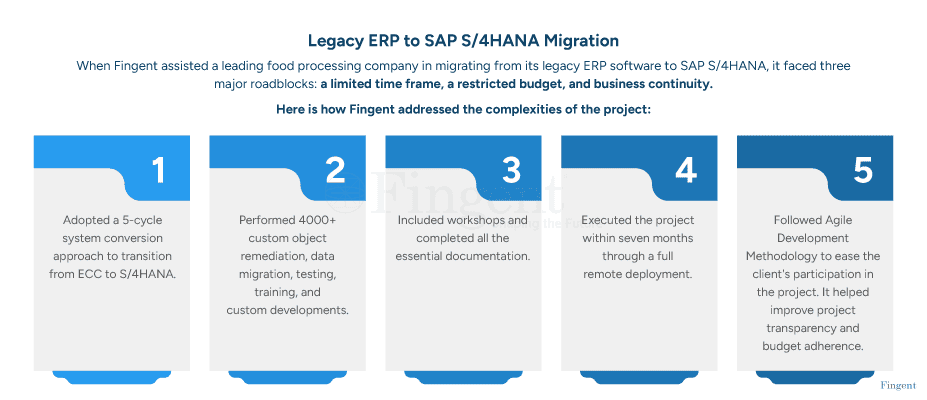
Myth #2: Migrating to S/4HANA Can Disrupt My Business
Not true if you plan beforehand. If you don’t want to start from scratch with a new implementation, Fingent can assist you with the Brownfield migration approach. Also known as System Conversion, the Brownfield approach lets you migrate to S/4HANA with minimal disruptions to your system.
Here is how Brownfield migration limits disruptions to your business:
- Upgrades only specific elements of your existing SAP landscape
- Allows retaining your customizations and historical data
- Helps re-examine and improve your existing processes
- Low cost of implementation, less time consuming
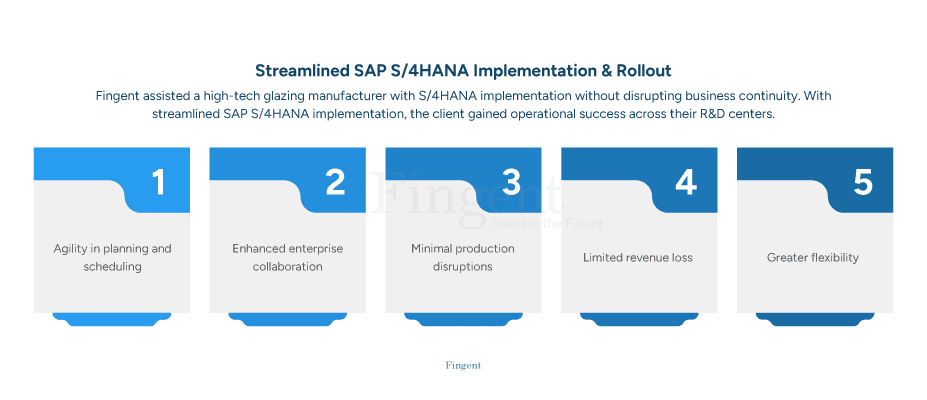
Myth #3: S/4 HANA Isn’t Compatible With My Industry Solution
S/4HANA is officially released for ALL industry solutions. Yet, it is important to understand if you can use S/4HANA with your current implementation.
- Find out the features that are not currently supported. For this, you can refer to the SAP Note.
- Compare the features supported with your list of requirements and solution usage.
- Another alternative is to review if you really need the features that are not supported. For this you can seek the support of SAP code inspector tool.
Myth #4: SAP S/4 Hana Is Only Available in the Cloud
S/4HANA comes in two editions, Cloud and On Premise that have an identical code line. The Cloud Edition can only be run in the SAP data center managed by SAP (SaaS). The On Premise Edition can be run in any of the following ways:
- On Premise (in your data center)
- In the SAP HANA Enterprise Cloud
- Using the services of a hosting partner
You choose On-Premise or Cloud Edition that makes sense for your use case.
How Can SAP S/4HANA Migration Secure and Future-Proof Your Business?
While there are many ERP solutions, SAP S/4HANA provides next-gen capabilities in:
- Enterprise resource management
- Business continuity and faster response time
- Compliance and security
- Advanced features for improved efficiency
- Access to a wide portfolio of advanced technologies
Here is how SAP S/4HANA is helping companies future-proof their business:
- In SAP S/4HANA, data is stored, managed, and accessed in a unique, secure way. It makes the platform significantly faster and more efficient than legacy ERP solutions.
- Gives organizations more control over the management information that exists within the organization.
- S/4HANA retrieves any information directly from the database. It allows organizational reports to be made available in real-time.
- S/4HANA’s IT architecture is based on the latest technological insights. This means the ERP package is ready for advanced tech such as IoT, AI, ML, and blockchain.
- S/4HANA is built to be the digital heart of organizations. It enables future developments to be incorporated into processes and reports with ease.
- Easy to run smooth communications with other (cloud) applications. Faster and stable connections to supplier and customer systems.
- Supports the business processes and agility essential for rapid acquisitions, reorganizations, and autonomous growth.
- Elevates the role of ERP from a mere financial reporting aid to a strategic tool. It enables businesses to gain competitive advantages.
How Can Fingent Help You With SAP S/4HANA Migration?
The 2027 deadline is looming and there is no better time than now to kickstart your SAP S/4HANA journey. Our SAP experts can work with your team to simplify your SAP S/4HANA migration journey. We can help your business:
- Discover the right migration approach that suits your business best
- Prepare customized migration strategies to reduce disruptions during migration
- Identify challenges and opportunities through comprehensive assessments
- Customization and optimization services to tailor S/4HANA to fit your purpose
- Ensure a smooth switch to S/4HANA with precise data migration and system integration
- Equip your team for the transition with holistic training and ongoing support
Fingent’s strong partnership with SAP gives us early access to the latest enhancements, tools, and resources that help you gain an edge over competitors.
Contact us to discover the best way forward for your S/4HANA migration project.
Stay up to date on what's new

Featured Blogs
Stay up to date on
what's new



Talk To Our Experts
SAP ECC is ending support in 2027, leaving leaders with one choice: migration to SAP S/4HANA. This strategic move promises business benefits like improved operational efficiency and advanced analytics. Although, the many advantages, the path to migration is fraught with many risks and challenges. What are these critical risks, and how can leaders prepare to mitigate them for a successful transition? This blog will help you explore the top ways to navigate SAP S/4HANA migration risks.
Drive Business Excellence with Pathbreaking SAP Solutions
An Introduction to SAP S/4HANA
The SAP S/4HANA system is modern ERP software that runs on the SAP HANA in-memory database. This enhances the system’s ability to process transactions faster and provides real-time reporting capabilities. It also has three modes of deployment: private cloud, public cloud, or on-premises.
S/4HANA also works effortlessly with older SAP programs as well as external systems. It connects all departments within the organization, ensuring smooth operations. The tools provided by the S/4HANA system will help organizations stay competitive with an upper hand.
Why is it Urgent to Migrate to SAP S/4HANA?
The digital world keeps progressing with impeccable speed. To stay significant in the current market, companies must adapt to upcoming trends. Listed below are some of the main reasons why migration to S/4HANA is an urgent matter:
1. End of Support for ECC
Companies currently using SAP ECC have no choice but to migrate to SAP 4/HANA. SAP has declared to end mainstream maintenance for SAP ECC by 2027. This means SAP will no longer offer regular updates, support, or security for ECC systems. Migrating to S/4HANA can help businesses stay relevant with effective operations and growth strategies.
2. Technological Advancements
In-memory computing processes data much faster than legacy databases. This enhances real-time analytics and reporting. The new simplified model is designed to reduce the complexity and size of the software database. This improves performance and cuts the cost of ownership. The advanced user interface for SAP 4/HANA also offers an intuitive and interactive experience.
3. Business Benefits
S/4HANA also offers real-time insights and integrative analytics. Its enhanced data processing causes real-time analytics. This enables organizations to make quicker and more informed decisions. It also has extra features, such as integrative analytics and machine learning. They enhance the company’s predictive capabilities.
4. Integration with Innovation
S/4HANA can integrate with existing SAP products seamlessly. This fosters innovation. Further enabling the optimization of emerging technologies like IoT, AI, and ML.
5. Cost Efficiency
S/4HANA opens up a plethora of long-term reduced-cost benefits. From reduced infrastructural costs to lower maintenance costs, it can lead to significant savings.
Choose SAP Solutions That Cater To Your Unique Business Ecosystem
What is the Difference between S/4HANA Conversion and Migration?
S/4HANA migration means transferring transaction data into another system. During this process, pre-project adjustments are not necessary. It is generally referred to as the Greenfield or Selective Migration Approach. It involves the setup of a new system and the migration of the initial data load.
System conversion, on the other hand, refers to converting an existing system. For instance, it could mean converting an SAP ECC system into an SAP S/4HANA system. This approach is also called the Brownfield Approach. Here, pre-project preparations are necessary. These preparations include data migrations and software customization.
Read more: Various Paths to SAP S/4HANA Migration – A Detailed Guide
What are the Challenges of Migrating to SAP S/4HANA?
With S/4HANA, companies can upgrade their IT infrastructure and boost business operations. Yet, this process comes with its fair share of challenges. These include change management, customizations and integrations that need careful handling, the need to maintain data integrity during transfer and more. Let’s discuss some of the challenges here. Following, you will read how to mitigate these S/4HANA migration risks.
1. Gaining Support from Senior Management
This is a crucial step during the migration process. It involves requesting the necessary resources and budget allocations. You will have to make promises about advancement’s alignment with business goals. Persuading stakeholders about the necessity of migration is challenging.
There must be effective communication about the technical requirements and the migration process. Emphasize the positive outcomes. Elaborate on how the investment will have cost-effective benefits in the long run. Draw attention to the enhanced efficiency, improved integration, and futuristic IT infrastructure.
2. Maintaining Effective Controls
During the migration process, many customizations and integrations are underway. These processes need to be handled carefully to ensure a successful migration. This step involves identifying potential risks and developing effective ways to mitigate risks. It ensures that the migration process is carried out safely and minimizes the chances of any adverse impact on operations. Furthermore, managing controls can protect data integrity throughout the migration process.
3. Data Migration
This is the main step in the SAP migration process. It involves transferring large volumes of initial data from one system to another. Data integrity is the top priority, followed by accuracy and consistency. Any mishap in this step could cause a recurring issue throughout the organization. Creating a strong migration approach is important for a seamless transition. This includes planning the data extraction, transformation, and loading processes.
Developing a data-centered framework that automates workflows is also important. It is well-advised to delete old data from the legacy system before the migration process. Skimming through the legacy system to delete any unnecessary data is crucial. This will help optimize the transaction data. Furthermore, it reduces the risk of migrating inaccurate information.
4. Change Management
Also known as dual maintenance, this term describes managing changes across landscapes. The complete transition will take time. Most companies cannot afford to pause their business operations. Here, it becomes vital to deliver changes across many landscapes seamlessly at the same time. It is crucial to ensure that S/4HANA landscapes mirror any changes made in the legacy systems. Dual maintenance can be a tiring task, but it is a necessity.
5. Custom Code Adaptation
The Custom Code developed by SAP requires many technological modifications. This way, the system software will be compatible with the S/4HANA system. Modification of custom code requires a thorough assessment. Check your legacy system for any incompatible codes. These are usually no longer within your productive business applications. This guarantees the utmost functionality and eradicates any potential post-migration problems.
What is the Biggest Risk when Performing a Database Migration?
Every project has its fair share of risks to look out for. The biggest risk for a S/4HANA migration project is data loss. Losing crucial data can cripple a business, so that is something that needs to be cared for. There are other risks involved as well that have the potential to crumble the project and stunt business operations. Listed below are some of the major risks to keep an eye out for:
1. Data Migration Challenges
The data migration to the S/4HANA process is the more risk-prone stage. The entire process is extremely complex. Consisting of high risks such as data loss, corruption, and compromised data integrity. These issues appear with differences in field gaps between legacy systems and S/4HANA.
2. Poor Planning and Migration Strategy
Ensuring you have an ironclad migration strategy is crucial. Without a proper plan, you may face delays, cost overruns, and data issues. Careful planning will ensure the mitigation of any irrelevant datasets.
3. Technical and Operational Risks
Technical risks, such as integration issues and incompetence in infrastructure, arise during migration. Evaluating your organization’s readiness for migration is a precaution. The proper implementation of appropriate tools must be a priority. This will have a direct impact on business operations and service levels.
4. Customization and Compatibility Issues
Companies are bound to get attached to their legacy system customizations. Especially when these systems have been running for many years. S/4HANA cannot always support these deep customizations. For example, an ABAP source code must be modified to the SAP code. This can sometimes become backward compatible and counterproductive.
5. Lack of Expertise
The migration process becomes complex with heavy data and many technical tools. The company then needs to hire professionals to do the job. This is not always a pocket-friendly option and may sometimes exceed the budget.
Master SAP S/4HANA Transformation! Know the Benefits, Impact, and Strategies To Success.
What are the Risks of Server Migration with the S/4HANA System?
The most common risk is the change in file structure on the application server. Regardless of the approach, most companies encounter this problem. This is due to a lack of professional experience with migration. As a consequence, organizations fumble and buy expensive extensions to the project.
Check the validity of the entries before migrating to technical roles. SAP programs read and write data on the file system to check the authorization of objects. Verifying the validity of these entries before the migration process will help mitigate the risk to the application server.
When you change migrated files, the termination of the program is prevented. These invalid values in authorization get stored as a short dump. This problem needs to be resolved before further testing. This could put the entire migration process on hold. Even system administrators have to work extra hard to analyze and correct such issues.
Strategies to Execute Safe and Seamless Migration
Organizations can install effective migration strategies during their S/4HANA migration process. These steps will make the process much smoother and help mitigate the S/4HANA migration risks.
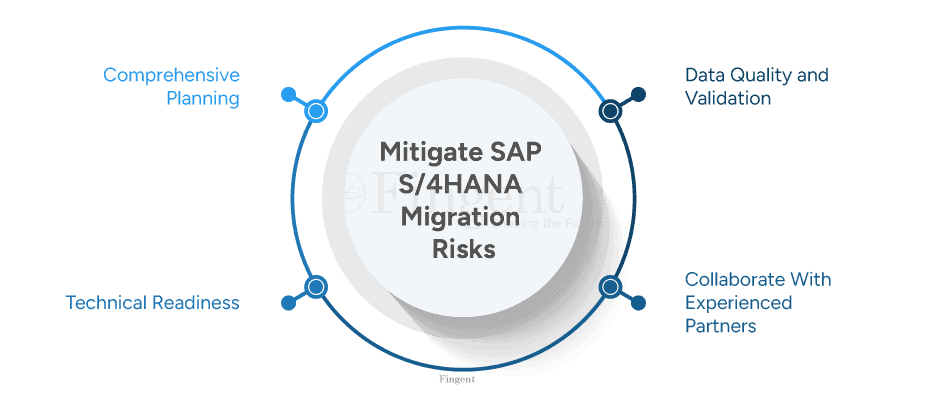
1. Comprehensive Planning
Planning should start with closely reviewing the organization’s current IT infrastructure. This will help you understand the scaling and parameters of the migration process. The next key step on the list is risk assessment. It will help you be prepared for any challenges that come your way. Assess all your options and select the right migration strategy for your organization. This is the first step in the migration process. An effective S/4HANA migration strategy must include a detailed timeline for each phase. It will also consider resource allocation and a risk management plan.
2. Data Quality and Validation
Do not underestimate the process of data validation. In this step, you will pinpoint data that is important and needs to be migrated. There must be residual data left in the legacy system to prevent overloading. Assess the data stored in legacy systems to root out any unnecessary elements. This is a great way to mitigate risk. The migration process provides the company with the chance to clean their data. This ensures the migration of only relevant and important data.
Businesses can use the SAP S/4HANA migration cockpit for this. It consists of programmed tools and templates that enable streamlining the migration process. This tool also helps companies regulate S/4HANA data migration activities. It also prevents errors and speeds up the timeline for the S/4HANA migration process.
3. Technical Readiness
Your company’s IT infrastructure must meet the technical requirements. Regardless of which method of migration you use, ensure to invest in the necessary hardware, software, and network upgrades.
4. Collaborate with Experienced Partners
The S/4HANA migration process is a complex transition. One might encounter technical issues in SAP S/4HANa migration journey. It should be handled by professionals with adequate experience. Otherwise, it can lead to many extra costs post-migration. Partnering with experienced consultants is highly recommended. It can also add value, insight, and best practices for successful migration. These professionals will help tackle the most challenging technical issues, guaranteeing a seamless transformation into the S/4HANA system.
Migrating to SAP S/4HANA with Fingent
According to statistics, over 21,707 companies worldwide will have started using SAP S/4HANA as an ERP tool. The migration process is a difficult one, but not with a partner as reliable as Fingent. Fingent has been an SAP Silver Partner and has more than 18 years of experience working with SAP’s products.
Fingent analyzes your IT infrastructure and provides tactical advice on choosing the right migration method. At Fingent, your migration process will have a unique perspective. Our experts will help you prepare, explore, configure, and deploy your project. We also provide post-migration support, project closure, and maintenance. As Certified SAP HANA specialists, we can help you migrate to SAP S/4HANA seamlessly.
Give us a call and let’s see the best way forward for your migration plans.
Stay up to date on what's new

Featured Blogs
Stay up to date on
what's new



Talk To Our Experts
SAP S/4HANA Transformation is paving the way for businesses to lead stress-free and effective operations. Offering reliable and flexible solutions, SAP S/4HANA is helping companies tackle changing market dynamics, the rapid evolution of new technologies, legacy processes, siloed data and departments, sudden disruptions in the supply chain, and more.
Thanks to SAP S/4HANA, the intelligent ERP system of the new generation is designed to help companies standardize and manage end-to-end processes. Improved speed and agility, enhanced predictability, and accelerated digital transformation are a few other perks of adopting SAP S/4HANA. However, successfully transforming your business with SAP S/4HANA needs strategic planning and the right approaches. This comprehensive guide aims to provide basic guidance to master SAP S/4HANA transformation.
Learn how SAP S/4HANA provides a flexible, end-to-end ERP solution for modern organizations
Why SAP S/4HANA Is the Game-Changing Digital Platform for Business Modernization?
Powered by the SAP HANA in-memory database, SAP S/4HANA is central to most enterprise transformation projects today. SAP S/4HANA transformation helps gain real-time data-driven insights, accelerates the pace of business, supports new cloud capabilities, enables usability, and drives innovation, all while streamlining and simplifying your business processes. It facilitates accelerated deployment by lowering costs with a standardized digital core and improves business agility through an open, modular, scalable, and innovative platform. Undoubtedly, we can say that SAP S/4HANA is a game-changer for your digital business strategy, and it is a vital blueprint that will aid you in your journey to becoming an intelligent enterprise.
- Numerous opportunities to apply data and pivot to new business models in a short span of time.
- Single source of facts to improve decision-making and complete business processes without leaving your current interface.
- Automation of tedious routine tasks to streamline business processes and free up workers to focus on more productive actions.
- Faster predictive analytics and insights enable huge efficiency and cost and time savings.
- Lowers infrastructure ownership and maintenance costs by enabling public or private cloud deployments along with SAP’s virtualization.
Become an Intelligent Enterprise with SAP S/4HANA. How?
How Can the C-Suite Derive Value From SAP S/4HANA?
“The longer your critical SAP operations remain mired in yesterday’s technology, the FARTHER YOU WILL FALL behind your competitors.” – Frost & Sullivan
As the financial engine that runs your business operations, SAP solutions are inextricably tied to your digital transformation strategy. Though most SAP customers have plans to move to SAP S/4HANA, many need help with execution. Here are a few practical tips on how CEOs and senior business leaders can accelerate SAP S/4HANA migration to reap business benefits more quickly.
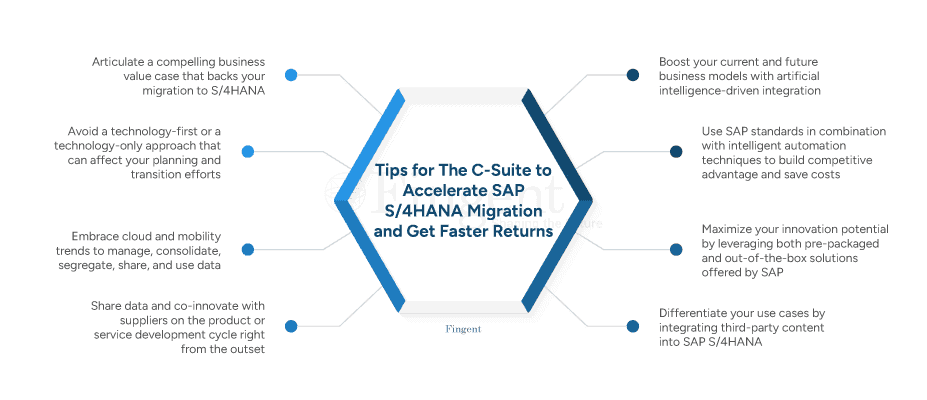
How SAP S/4HANA Transformation Benefits Your Digital Growth Strategy?
SAP S/4HANA aligns with your organization’s needs and provides clarity amid the evolving digital business landscape.
- Simplified, real-time insights to make well-informed decisions.
- Deep personalization to deliver an intuitive and relevant user experience.
- Cloud readiness and adoption powered by a simplified IT landscape.
- Easy to integrate with your existing business applications and solutions.
- Scalable digital core that evolves with your growing business needs.
- Automation capabilities to save your effort and enhance productivity.
- Reduce your IT infrastructure ownership and maintenance costs.
Choosing the best IT Infrastructure for SAP HANA!
Leading Industries That Benefit From SAP S/4HANA Transformation
1. Supply Chain & Logistics
SAP S/4HANA supply chain management offers a collection of LOB modules, including Sourcing and Placement, Extended Procurement, Manufacturing, Supply Chain, and Asset Management centered around processes for supplier relationship management and supply chain management.
- Early visibility into sales, purchase, and stock transport orders to facilitate planning and scheduling of goods in transit.
- Single warehouse management platform to optimize labor, processes, and warehouse operations.
- Live inventory management with automated and transparent material flows.
- Built-in transportation management to plan, manage, and carry out transports end-to-end.
- Extensive portfolio of software to address every supply chain need.
2. Retail
SAP S/4HANA Retail connects your retail processes across the entire value chain to increase efficiency in real-time and provide an end-to-end real-time experience.
- Empower your store associates and managers with real-time customer and product information.
- Actionable insights to serve customers effectively and deliver world-class shopping experiences.
- Steer your company in real time by adjusting rapidly to changing business needs.
- Understand every aspect of your business and take advantage of new revenue opportunities.
3. Financial Services
SAP S/4HANA Finance allows CFOs and finance professionals to gain insights into a business’s financial aspects, including financial accounting, controlling, treasury and risk management, financial planning, financial close, and consolidation.
- Predictive analytics and insights generation capabilities to enhance visibility across business functions.
- Accurate budgeting, planning, and forecasting based on real-time data and prediction of future outcomes.
- Optimize risk management and establish a cost-effective approach to effectively respond, adapt, and survive in the wake of uncertainties.
- Intelligent automation for every finance process – from accounting to risk management.
4. Healthcare
SAP S/4HANA for Healthcare offers smart healthcare industry solutions to drive high-quality, cost-effective care and improved patient outcomes.
- Cut through complexity and reduce paperwork, freeing healthcare workers to focus on strategic tasks.
- AI-driven healthcare software to control costs, reduce resource constraints, and run efficiently.
- Analysis of health data from electronic medical records and medical sensors to personalize patient care delivery.
- Pursue sustainable healthcare: zero emissions, zero waste, and zero inequality.
Why Do Businesses Need to Switch From SAP ECC to SAP S/4HANA?
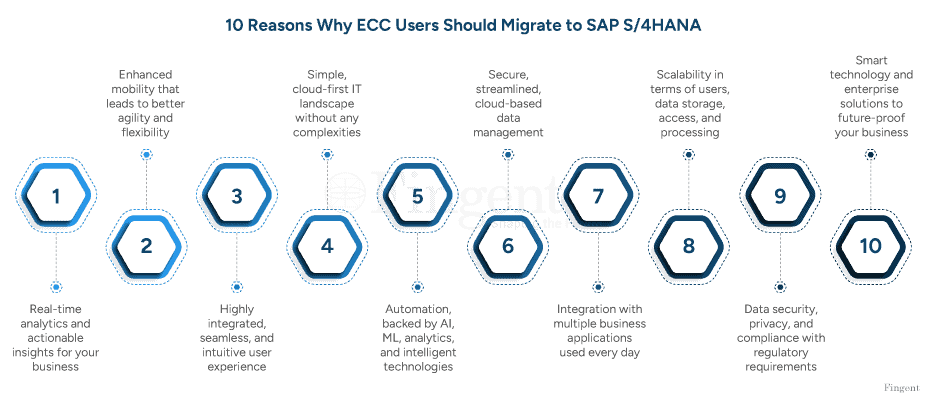
SAP will support ECC and other core Business Suite 7 applications until the end of 2027, with optional extended maintenance until the end of 2030. It’s wise for the current SAP ECC customers to prepare for an SAP S/4HANA Migration soon. Here’s a quick rundown of the basic differences between SAP S/4HANA and SAP ECC.
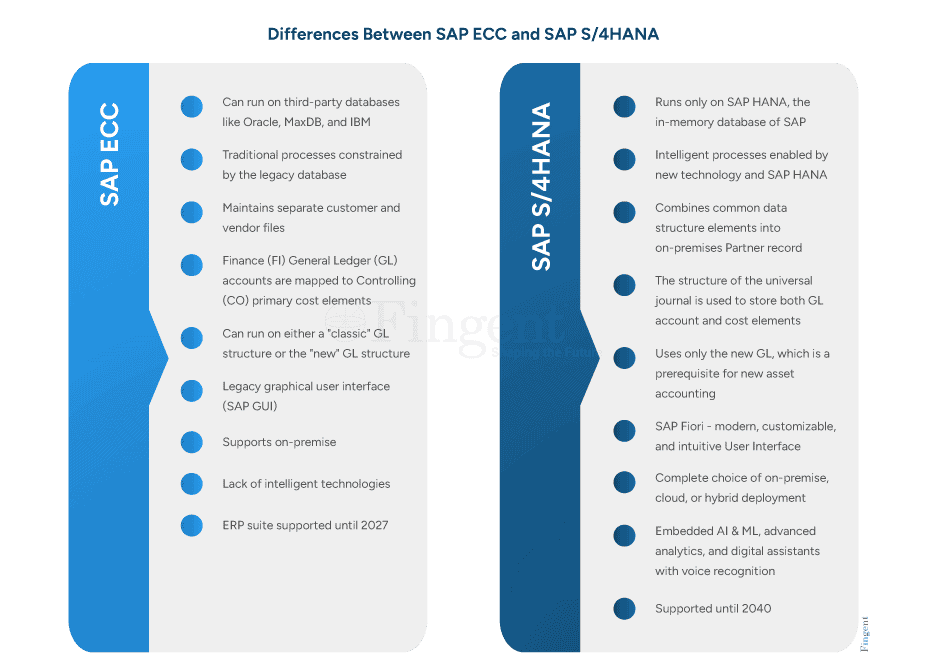
Benefits of Moving from ECC to S/4HANA
- Simplified data architecture and technology landscape.
- Leverage AI, ML, analytics, and automation to power innovative solutions.
- Speed to market, business growth, and expansion.
- Consistent user experience across all channels, platforms, and devices.
- Real-time data insights to improve decision-making.
- Stay ahead of the competition with a next-generation ERP suite.
Strategizing a Successful SAP S/4HANA Implementation Project
With SAP planning to eventually sunset ECC, implementing SAP S/4HANA will be inevitable for all existing SAP users.
Here are a few steps to consider when preparing for SAP S/4HANA implementation.
- Define your SAP S/4HANA implementation goals and objectives.
- Assess your organization’s readiness to adapt to the changes.
- Develop a detailed implementation plan with predefined milestones.
- Ensure you get adequate support from business leaders and the C-suite.
- Redesign legacy business processes so they adapt quickly to S/4HANA.
- Install, customize, and configure S/4HANA to match your specific needs.
- Migrate your legacy data from non-SAP or older SAP systems to S/4HANA.
- Test the new SAP environment thoroughly to resolve errors and bugs.
- User training, go-live, and post-implementation support and maintenance.
Transforming successfully with SAP S/4HANA requires a unified IT vision that can be translated into an actionable plan
How to Successfully Migrate to SAP S/4HANA?
Business leaders and C-level executives often require speed in executing efficiency. Transforming business with SAP S/4HANA can also be a streamlined and quicker journey with established policies for digital success and innovation.
- Set the tone for your organization and employees to become change-resilient.
- Adopt a hybrid or multi-cloud strategy that prioritizes critical workloads to become cloud-ready.
- Save development time by replacing cumbersome versions of SAP Business Suite with flexible SAP S/4HANA.
- Ensure the availability of team members and budget when planning SAP S/4HANA implementation.
- Be sure all business leaders are accountable for meeting deadlines and assigning resources to the project.
- Engage a certified SAP partner to accelerate S/4HANA migration and predictably manage IT costs.
How Businesses Can Accomplish a Smooth and Swift Transition to SAP S/4HANA?
- Analyze the right deployment option (On-Premise or Cloud) that fits your business requirements and budget.
- Evaluate if data cleansing is required to avoid licensing risks and downtimes.
- Create a detailed business roadmap to provide end-to-end technical support for seamless data migration in s4HANA.
- Create SAP Sandbox environment initially as a proof of concept (POC) to test the workarounds in real-time.
- Methodical and systematic execution from planning to migration is successful migration of legacy SAP system to SAP S/4HANA.
- Provide ongoing support and maintenance to ensure your SAP S/4 HANA environment functions without glitches.
Seven Tips To Ensure A Seamless Transition To SAP S/4HANA
Choosing an SAP S/4HANA Migration Approach That Ensures Business Continuity
Large volumes of historical and incumbent business-critical data and complex system landscapes require enterprises to adopt a well-defined S/4HANA migration approach. The best migration technique helps organizations ensure business continuity, embrace innovation, and stay relevant and competitive.
Selective Data Transition, aka Hybrid Approach or Landscape Transformation, is a popular S/4HANA migration approach that enables organizations with multiple ERP systems to consolidate everything into a single source of truth. If required, SDT allows historical data to be kept, converted and transformed to fit the new S/4HANA configuration.
- Performance optimization, secure and practical implementation.
- Improved functionality and agility, competent and compliant infrastructure.
- Supervised implementation reduces downtimes, risks, and costs.
- Uninterrupted data transfer and modernization of IT processes.
Tools for SAP S/4HANA Implementation
Data migration is an important part of any system implementation. SAP provides user-friendly, state-of-the-art tools to ensure that your data is of high quality and assists you in achieving your organizational goals, post the migration to S/4HANA. These tools are easy to use and help reduce your test efforts and downtimes.
- SAP S/4HANA Migration Cockpit
- SAP S/4HANA Migration Object Modeler (MOM)
- SAP Rapid Data Migration with Data Services
- SAP Readiness Check
- Guided Configuration for SAP S/4HANA
- SAP Landscape Transformation (SLT) Software
The Final Word
To remain competitive, businesses must ensure their critical operations are fully modernized and cloud-ready. Migrating legacy SAP Business Suite to SAP S/4HANA will make your business more agile, efficient, and cost-effective. However, the migration must be carefully considered as part of a strategic cloud initiative.
Our strong partnership with SAP gives us early access to new enhancements, tools, and features that enable your business to gain an edge over competitors.
Learn more about how SAP S/4HANA transformation can boost your business to unlock new possibilities.
Stay up to date on what's new

Featured Blogs
Stay up to date on
what's new



Talk To Our Experts
One-size-fits-all? Not anymore, and definitely not when it comes to SAP S/4HANA! If you’ve made the choice to transition from your legacy systems to SAP S/4HANA, then you’re on the right track! It is surely the first step towards business transformation. However, the next step is crucial, i.e., finding the right path to SAP S/4HANA Migration. Many factors are unique to your business, including your current system layout, business needs, and long-term goals. Your migration path can be defined based on these factors to drive a successful transition journey. Explore the various paths to SAP S/4HANA migration in this blog, and identify what suits your business the best!
Ease Your SAP S/4HANA Migration Journey With Us
1. New Implementation (Greenfield Approach)
What Is the Greenfield Approach?
The Greenfield approach is essentially a completely fresh start with a new S/4HANA. This approach allows you to redesign and optimize your business procedures from scratch. It is also referred to as ‘a new implementation’.
The new implementation approach completely reengineers the system, which could simplify processes with a technological backbone. All systems are reinstalled and re-coded to fit business needs. The Greenfield approach is suitable for new and existing customers alike. It helps multifaceted and complex systems simplify their processes. Let’s explore some benefits and challenges of the Greenfield approach.
Benefits:
- Fresh start: During the Greenfield approach to transformation, existing in-house developments and third-party systems undergo a thorough examination. This helps business owners find the root cause of any shortcomings or mishaps. Re-starting with a clean slate can ensure that no incompetence is carried forward from legacy systems.
- Process Optimization: This approach and reinstalling systems also encourage business owners to redesign business processes from scratch. It eliminates the need to adjust old processes to conform to industry standards. It helps you focus on the current needs and standards and implement them. This way, you can fully leverage S/4HANA capabilities.
- Latest Features: Classical in-house developments in the core system are being replaced by new architectures. The Greenfield approach can achieve these architectures. The new architectures allow regular modernization through rapid updates. Instead of major upgrades, these architectures focus on subareas. They continuously update the system’s smaller, more integral aspects, and the entire system is completely renewed in a few years.
Considerations:
- Cost, time, and history: The biggest fear concerning the Greenfield approach is its cost. Starting from scratch may feel like a regression and require more effort and longer project timelines. Another note is that the new implementation may lead to losing historical context that is still relevant to your business.
- Change in Management: A clean slate entails a complete shift in management. This may affect employees and users as they must get accustomed to the new system.
2. System Conversion (Brownfield Approach)
What Is the Brownfield Approach?
Also known as System conversion, the Brownfield approach enhances your existing SAP ERP system. This approach lets you migrate to SAP S/4HANA without causing much disruption to your existing system. It upgrades only specific existing elements of the SAP landscape, such as interfaces to suppliers and partners. With the Brownfield approach, you can retain your systems’ customizations and historical data. The system conversion approach allows you to re-examine your existing processes and improve the lagging ones.
Benefits:
- Reduced Disruption: Whereas it might feel like your system is shaken to its core with the Greenfield approach, the Brownfield approach is gentler. There is minimal disruption to the users. The loss of previous customizations is also prevented.
- Cost-effective: This approach does not require a complete reboot, so the cost of implementation is low. It is also not time-consuming and is best suited for companies already associated with SAP ERP.
- Data Continuity: This approach only upgrades systems, leaving all historical data untouched. It also removes the need to migrate customizations.
Considerations:
- Technical Complexity: It is sometimes viewed as a stifling innovation. This is because all the previous data from your SAP ERP is being ported over without any modifications. This process requires thorough preparation and testing.
- Customization Clean-up: This approach requires users to manually clean up incompetent customizations and useless data to leverage S/4HANA fully.
3. Selective Data Transition or Bluefield Approach
What Is the Bluefield Approach?
Greenfield and Brownfield, together, give birth to the Bluefield Approach. This approach, also known as the selective data transition, involves transitioning only selected data and processes to the S/4HANA system. It allows you to enhance certain areas while seamlessly retaining others. This hybrid approach takes on the best of both the parent “fields” and is becoming the most preferred approach.
The Bluefield approach best suits large-scale enterprises with extensive data and complex systems. With this approach, you can eradicate any problems you may otherwise face with the Greenfield and Brownfield approaches. You can handpick aspects of your system that you want modified. These can be enhanced while your current system remains unbothered by data cleaning and migration into the new system.
Benefits:
- Flexibility: Since you can select which aspects of the system you want updated, this approach is highly flexible and can be adjusted to meet your unique business needs.
- Process Improvement: You can enhance only the key processes that require optimization without re-starting from scratch.
- Data Control: Another key advantage is that you can pick what customizations to retain and which historical data to migrate. All the data tabs are under your supervision and control. This also benefits users, as they do not have a complete perceptual shift.
Considerations:
- Complex Planning: All the aforementioned benefits can be reaped only with thorough planning. Since you have to select parts of the system to upgrade, there is a lot of effort spent on preparation. The new system needs to be tested and validated. Data needs to be mapped accurately. Customizations have to be replicated. All this needs to be done before migration and usually calls for a team of experts or a third-party tool
- Balanced Approach: Balancing the old and new system elements without losing track of them is the challenge. Handling the aftermath of the implementation is where the real work begins. This includes expert Change Management to ensure smooth transitioning. Employees must be trained to handle this hybrid system as well.
4. Central Finance
What Is the Central Finance Approach?
Central Finance is a novel approach. It involves implementing S/4HANA Finance as a central system simultaneously with your existing ERP system. SAP Central Finance is a system that is used to receive data pivotally from multiple source systems. It then transforms and processes financial data at your pace, with your ERP in the background.
Benefits:
- Gradual Transition: Because it works with the backdrop of your existing ERP, it follows a phased approach. This allows users to move at their own pace, and migration happens according to the user’s wishes.
- Financial Insights: It establishes a streamlined source for consistent reporting and analysis. With real-time replication of financial data, it provides information for intelligent decision-making on the go and instant advice to enhance financial processes.
- Consolidation: All the financial data that flows into the system is consolidated into a unified view. This gives users centralized access to all relevant information. Users can thus analyze their transactional processes without any hassle.
Considerations:
- Integration Effort: Since data is received from multiple sources, communication must be robust between these sources and the central S/4HANA system. Maintaining seamless integration among these two can be time-consuming and require expert manpower.
- Limited Scope: As the name suggests, this system is bound to focus on the financial aspects of the business. This may not always be helpful and can lead to stunted migration later.
SAP ECC to SAP S/4HANA Migration: Why Act Now?
How to Choose the Right Path?
Every business has a perfect integration path fit. As you have seen, there are multiple approaches you can choose from. Whatever path you decide to take will depend on several other factors. Factors such as your current system landscape, business goals, project timeline, and company budget. Below are a few things you should consider before deciding which integration path to take.
- Assess Current System: Assess your current state – your ERP system, customizations, data quantity, and quality. Examine how each path will impact your company’s efficiency and try to predict what your business will look like after implementation. Assessing your budgets, project timelines, and current system landscape is essential.
- Define Objectives: Take a step back and reevaluate your business objectives and goals. Draw a strong link between your business goal and S/4HANA. This will help you clarify your priorities before you move forward.
- Consult Stakeholders: Ask for advice amongst your most trusted. Involve your key stakeholders from various departments in your business. Consider their opinions and ensure that they are on board with the implementation plan. They will need to put effort into gathering input and preparing for the migration.
- Plan Thoroughly: A well-thought-out plan is least likely to fail. Don’t spare any effort in developing detailed, foolproof migration plans. They should include timelines, resource allocations, and risk mitigation strategies. Always be prepared with a post-implementation plan as well.
- Engage Experts: Consider involving SAP consultants or partners. Their expertise in S/4HANA migrations will certainly guide you through the process.
Transforming Your Business with Fingent
Statistics show that, in 2024, over 20807 companies worldwide will have started using SAP S/4HANA as an Enterprise Resource Planning (ERP) tool. The question then is not if but when you will migrate.
Granted, the process of migration is never an easy one. Nonetheless, transitioning to SAP S/4HANA is a journey worth taking. It can make a monumental difference in your business capabilities. By considering and learning about the different integration paths, you can become more prepared for this change. By carefully planning your approach, you can ensure a seamless transition that meets your unique needs. Regardless of your method, moving to S/4HANA will boost your organization for future growth and progress. Begin your transition process today and enjoy the benefits of S/4HANA to the fullest. With decades of experience in helping clients with SAP products, our team at Fingent can help you find and journey through the best migration path for your business. Let’s talk.
Stay up to date on what's new

Featured Blogs
Stay up to date on
what's new



Talk To Our Experts
It’s official! SAP will end ECC support in 2027. SAP ECC has been a cornerstone for many industries and has undoubtedly had a good run. But now it’s time to embrace change! Over the years, industries have evolved with the changing digital landscapes. The end of ECC support is yet another distinctive change compelling businesses to transition with time. But why are experts urging SAP ECC to SAP S/4HANA Migration? What happens if companies still stick with ECC, and how can one plan a smooth SAP ECC to SAP S/4HANA migration? Learn all this and more in this five-minute read!
Ready to Migrate to SAP S/4HANA?
Why Switch From SAP ECC?
The 2027 deadline is fast approaching! Have you considered the aftermaths of sticking with SAP ECC? Continuing to use SAP ECC after the end of support would mean managing outdated technology. For one thing, you will be crushed under higher maintenance expenses. More importantly, your business will have to tackle significant security vulnerabilities.
Can you afford to let your business fall behind while your competitors upgrade to cutting-edge, supercharged systems?
Opting out of transitioning to SAP S/4HANA is basically giving up on the latest features and improved security measures. It’s like refusing a fully loaded lifeboat while your ship goes down.
What Happens if I Choose to Stay With ECC?
To put it bluntly, it could very well take you down. It’s time to jump on the SAP S/4HANA lifeboat before you drown. Here are some sound reasons:
1. Lack of Flexibility and Agility:
With ECC, flexibility becomes a challenge because upgrades are difficult. The interface between extensions and SAP code with ECC is lacking. ECC also relies on batch processing, which significantly slows down response times. This makes upgrades more time-consuming and complicated, directly affecting the business’s ability to scale and adapt.
2. Impediments to Modernization:
SAP ECC runs on different database systems than HANA. Though this provides a level of flexibility, it does not meet the standards of the HANA database. In addition, crucial technologies that run the modern world, like AI, machine learning, RPA, etc., are not available in ECC. The fact that ECC cannot be deployed on the cloud is reason enough to say it’s time to move out.
3. Complicated User Experience:
User Experience is often underestimated, but to be true, it is the most important aspect of any technology. The traditional user interface that SAP ECC offers focuses on the business function. This served a purpose for a time but was complicated to a normal end user. However, the need of the hour is a more role-based and easy-to-use interface. A system that can be used by anyone.
What Is the Advantage of S/4HANA Over ECC?
Transitioning from SAP ECC to SAP S/4HANA is a true upgrade. It’s promising revolutionary progress for businesses with in-memory computing abilities, simplified data models, cloud enhancements, and refreshing user experiences. Here’s a detailed view of the distinctive advantages of SAP S/4HANA over ECC.
1. In-Memory Computing: SAP S/4HANA employs in-memory processing technology with SAP HANA. This significantly speeds up data processing and analysis. Thus offering instantaneous insights and decision-making abilities. Old-fashioned disk-based ECC databases may be sluggish and unresponsive.
2. Simplified data model: SAP S/4HANA’s simplified data model eliminates duplication and lessens the requirement for data reconciliation.
3. Improved User Interface: S/4HANA’s SAP Fiori interface offers a contemporary, user-friendly experience. It allows users to work faster and more efficiently, increases application adoption, decreases errors, and saves training costs.
4. Sophisticated Analysis: S/4HANA has integrated, predictive, instantaneous analytics built into the system. On the other hand, ECC frequently necessitates additional tools to achieve these functions, resulting in fragmented and delayed insights.
5. Cloud Capabilities: S/4HANA has been created with cloud integration as a priority. This powers business operations with increased scalability and flexibility. In comparison, ECC has limitations, which will only increase with the support deadline.
6. Automation and AI Integration: S/4HANA facilitates the incorporation of advanced technologies such as AI, machine learning, and robotic process automation. This allows for more intelligent and effective business operations, while ECC’s abilities in these areas are restricted and frequently need significant customization.
7. Simplified Business Operations: SAP S/4HANA offers integrated end-to-end solutions. Think of it like running a well-oiled machine, where everything works together effortlessly. Not so with ECC, which is a disjointed and standalone approach.
Connect With SAP Experts To Plan Your Migration Approach
Why Seize the Moment Today and Switch to SAP S/4HANA?
Switching to SAP S/4HANA now can gain you numerous perks:
1. Cost Savings: Early migration spreads the investment, avoiding high costs associated with a rushed transition. It’s akin to booking tickets in advance to avoid exorbitant prices later. Moreover, as the 2027 deadline nears, migration service demand will surge, likely raising costs.
2. Avoid Last-Minute Complications: A planned migration minimizes disruption to business operations. Procrastination only sets the stage for slip-ups and system glitches. It’s like gearing up for a marathon: steady prep beats any last-minute sprint.
3. Maintain Business Efficiency: Early migration enables immediate benefits from SAP S/4HANA’s enhanced capabilities, preserving and enhancing operational efficiency. Why get left in the dust with old tech when you can glide ahead with the latest?
How Can Fingent Simplify the SAP S/4HANA Migration Journey?
At Fingent, we have experts who can walk you through the changing SAP trends and help you discover migration approaches that best suit your business. Our consultants can prepare customized strategies just for you, ensuring minimal disruption during migration. We identify challenges and opportunities through comprehensive assessments, streamlining the migration process effectively.
With precise data migration and integration, we ensure a smooth transition. We empower your business with enhanced capabilities. Our customization and optimization services tailor SAP S/4HANA to fit your specific needs. This maximizes efficiency and productivity. With comprehensive training and ongoing support, we equip your team. Trust Fingent to navigate your ECC to SAP S/4HANA journey seamlessly. Unlock new growth opportunities and success.
Collaborate with Fingent today for a smooth shift to SAP S/4HANA, opening up possibilities for growth. Avoid procrastination – keep ahead by choosing Fingent as your migration partner.
Stay up to date on what's new

Featured Blogs
Stay up to date on
what's new



Talk To Our Experts
In today’s fast-paced business world, staying competitive goes beyond traditional strategies. The digital age requires a seamless blend of cutting-edge technologies. SAP, a global leader in enterprise software, offers a powerful solution – SAP S/4HANA Cloud and SAP Business Technology Platform (BTP).
In the journey of digital transformation, the collaboration of SAP S/4HANA Cloud and SAP BTP is a formidable alliance. This synergy streamlines operations and sets the stage for ongoing innovation. In this blog, let’s explore how SAP S/4HANA Cloud and SAP BTP shape the future of business, making transformation a continuous and evolving reality.
The Top Benefits of Integrating SAP S/4HANA Cloud and SAP BTP
In the ever-evolving landscape of digital transformation, the strategic combination of SAP S/4HANA Cloud and SAP Business Technology Platform (BTP) emerges as a game-changer. This powerful alliance not only streamlines business operations but also unlocks a myriad of benefits that propel organizations toward unparalleled efficiency and innovation. Let’s delve into the top advantages that businesses can harness by integrating these two robust SAP solutions.
1. Seamless Integration for End-to-End Processes
In the pursuit of operational excellence, the integration of SAP S/4HANA Cloud and SAP BTP shines as a beacon. By seamlessly connecting disparate business processes, organizations break down silos and achieve a unified, end-to-end view of their operations. This ensures not only streamlined processes but also empowers decision-makers with comprehensive insights, fostering collaboration and efficiency across the entire business spectrum.
2. Accelerating Innovation with Intelligent Technologies
The amalgamation of S/4HANA Cloud and BTP isn’t just about integrating systems; it’s about propelling innovation through intelligent technologies. S/4HANA Cloud leverages the power of artificial intelligence and machine learning, while BTP provides the platform to seamlessly integrate these intelligent technologies. The result? An innovation powerhouse that enables organizations to stay ahead of the curve, automate processes, and create new possibilities for growth and competitiveness.
3. Real-Time Analytics and Insights
In the digital age, information is power, and the combined might of S/4HANA Cloud and BTP ensures that power is harnessed to its fullest potential. S/4HANA Cloud’s in-memory computing capability facilitates real-time analytics, providing instant access to critical insights.
Complementing this, SAP BTP plays a pivotal role in enabling real-time analytics and harnessing data-driven insights. This not only enhances decision-making processes but also transforms raw data into actionable intelligence, fueling a proactive and agile business environment.
4. Agility and Flexibility in Cloud-Based Solutions
Agility is non-negotiable in the fast-paced business environment, and the integration of SAP S/4HANA Cloud’s cloud-native architecture with SAP BTP sets the stage for unparalleled flexibility. This collaboration allows businesses to respond swiftly to market changes and evolving demands. Integrated with SAP BTP, these cloud-based solutions empower organizations to navigate uncertainties with agility, ensuring seamless alignment of technology with business needs.
5. Integrated Development and Extension Scenarios
SAP BTP simplifies the development and extension of applications, streamlining the process for businesses to customize and enhance their solutions. This integration accelerates the development lifecycle and equips organizations with the tools needed to create tailored applications precisely aligned with unique requirements. The collaboration between S/4HANA Cloud and BTP fosters innovation and efficiency in the development and customization of solutions.
6. Data Management and Governance
Effective data management is fundamental for successful digital transformation. SAP S/4HANA Cloud contributes robust capabilities for data management, while SAP BTP ensures governance, offering a comprehensive approach to maintaining data integrity in the digital landscape. This collaboration enhances data quality and establishes a framework for responsible and compliant data practices, ensuring a solid foundation for digital initiatives.
7. Security and Compliance
In an era where data breaches are a constant threat, the security of digital assets is paramount. SAP S/4HANA Cloud addresses security considerations within its infrastructure, and SAP BTP plays a pivotal role in ensuring compliance with industry regulations. Together, they provide a comprehensive security blanket, safeguarding businesses against risks and ensuring the integrity of sensitive information through a unified security and compliance framework.
8. Scalability and Cost Optimization
As business landscapes evolve, technology must evolve with them. SAP S/4HANA Cloud’s scalability features, coupled with the cost optimization potential of cloud-based solutions, ensure that businesses can scale resources based on demand. This collaboration not only enhances operational efficiency but also guarantees long-term value through scalable and cost-effective solutions, aligning technology seamlessly with evolving business requirements.
Driving Business Excellence: A Case Study on How SAP S/4HANA Cloud and SAP BTP Propel Efficiency
A case in point is Corvias, a real estate innovator, as highlighted in a recent SAP news article. Let’s delve into this use case to understand how the combination of SAP S/4HANA Cloud and SAP BTP has driven efficiency and excellence for Corvias.
Corvias: A Case Study in Efficiency Maximization
Corvias faced the challenge of optimizing their complex real estate operations, spanning housing, construction, and property management. By implementing SAP S/4HANA Cloud and SAP BTP, Corvias experienced a holistic transformation. The seamless integration of end-to-end processes, from financials to supply chain management, broke down operational silos, providing Corvias with a unified view of their business.
- Agility and Flexibility: The cloud-native architecture of S/4HANA Cloud enabled Corvias to respond to market changes swiftly. Integrated with SAP BTP, the solutions provided unprecedented flexibility, allowing Corvias to adapt its technology infrastructure to evolving business demands.
- Innovation Acceleration: Leveraging the intelligent technologies within S/4HANA Cloud, Corvias embraced artificial intelligence and machine learning. SAP BTP facilitated the integration of these intelligent technologies, fostering innovation in processes, predictive analytics, and decision-making.
- Real-Time Analytics and Insights: In-memory computing in S/4HANA Cloud empowered Corvias with real-time analytics. SAP BTP’s role in enabling real-time analytics ensured that decision-makers had access to critical insights, driving informed decision-making across the organization.
The results were tangible – streamlined processes, enhanced collaboration, and ultimately, maximized results. The success story of Corvias exemplifies how the integration of SAP S/4HANA Cloud and SAP BTP can drive business excellence.
Read more: SAP S/4HANA Cloud Migration – All That You Need To Know!
Leveraging SAP Tools with Fingent
Wondering how to make the most of modern SAP tools? Fingent, a seasoned expert in SAP solutions, provides a robust suite of services. Collaborating with Fingent offers:
- Seamless Integration: Fingent excels in integrating SAP systems, ensuring a smooth flow of information across organizations.
- Customized Development and Extensions: Leveraging SAP BTP, Fingent creates bespoke applications tailored to specific business needs, boosting innovation and efficiency by aligning technology precisely with unique requirements.
- Top-notch Data Management, Governance, and Security: Fingent’s SAP data management expertise, combined with SAP S/4HANA Cloud’s governance capabilities, ensures the integrity and security of critical data. Collaborating with Fingent guarantees a secure and compliant digital environment.
Unlock efficiency, innovation, and security by harnessing SAP tools and Fingent’s expertise. Take the leap towards a tailored, scalable, and secure digital future – collaborate with us today!
Stay up to date on what's new

Featured Blogs
Stay up to date on
what's new



Talk To Our Experts
“Our future success is directly proportional to our ability to understand, adopt and integrate new technology into our work.” – Sukant Ratnakar – CEO, Quantraz Inc.
Since the dawn of its creation, SAP has been an incredible partner for businesses and organizations. The creator’s dream, to empower customers with the ability to interact with a common database for an all-round range of applications in real-time, continues to thrive even today. Many businesses that are already SAP customers are migrating to the fresh and new S/4HANA module. This comes as no shock, seeing as how beneficial this module is to business process workloads and applications.
If you plan to make this smart shift too, keep reading to better prepare yourself for this adventure!
What Is S/4HANA?
Before we delve into the need and benefits of this new SAP module, let us first re-learn its basics.
S/4HANA is an ERP business suite built on the SAP HANA in-memory database that allows businesses to manage transactions and analyze company data in real-time. It is the central focus, or “digital core,” of SAP’s approach to helping clients go through digital transformation.
Digital transformation allows businesses to change current workload processes and models or build new ones. As a result, they are more equipped to adapt to shifting market conditions, client needs, and business requirements. According to 6sense, SAP S4/HANA currently has 25,595 satisfied customers across the globe, and according to SAP Insider, 24% of businesses have already migrated to S/4HANA.
The Need To Migrate!
Consistently upgrading and migrating to newer technology is a necessity for businesses today. Although you may feel like you have time before you absolutely need to upgrade to S/4HANA, it is imperative that you start the SAP S/4HANA transformation process as soon as possible. Listed below are two reasons why:
1. Time-Intensive Planning Requirements.
The conversion process may take two years or longer, depending on how complicated your system is. This is especially true if you want to pursue an agile and flexible strategy that reduces risks and effects on the business and offers an easier return on investment! Remember that for a successful and low-risk system conversion, data streamlining—including cleaning tasks, customizations, and licenses – must also be taken into account.
2. Avoid Chaos In 2027.
Starting in 2027, SAP Business Suite 7 (including SAP ECC 6) will no longer be supported by SAP. Their consulting partners will be in more demand over the coming years to assist companies with upgrades in order to meet this deadline. Experts in SAP and cloud computing are in high demand, and the longer you wait, the harder it will be to locate qualified assistants who will not take advantage of the hurry and charge exorbitant fees for their services.
Top Benefits
The benefits of migration are strong, which makes it all the more important to take that leap. Businesses will be able to concentrate on development and expansion rather than the technical details of integrating several IT systems when they use S/4HANA. According to studies, S/4HANA has the following benefits:
- 10%-15% lower logistics costs
- 25%-30% shorter manufacturing cycles
- 10%-15% higher productivity
Flexibility is the greatest perk of this module. SAP HANA offers flexible access to any users who desire to utilize it with ease.
Listed below are a few major reasons why you should migrate to S/4HANA:
1. Enhanced Accuracy Due To Analyses
Simplifying data structures and introducing the Universal Journal have made it possible to slice and dice data in real-time using the capabilities of an in-memory HANA database This accelerates accurate analysis. As a result, with a few straightforward visualization tools like SAP Analytics Cloud, you can quickly access precise data.
2. Simplification
Every piece of data is automated. This makes it easy for businesses to develop suitable strategies even when expanding. Real-time insights will also be referenced in the attractive layouts and user-friendly interface. As a result, businesses will be able to process data online and instantly modify things through devices.
3. Agile And Innovative
When implementing standard and commoditized business processes, you can concentrate on those that give you a competitive edge over your competition. It is considerably simpler to integrate with other best-of-breed applications due to the straightforward data structures and simple integration with the public cloud innovation platform. A flexible architecture is the foundation of invention and agility. Other benefits include increased productivity, enhanced user experience, resilience, and many more.
The Best Strategy To Migrate
The procedure of migration to S/4HANA is an important part of your business’s legacy. Simply put, this process includes two parts: first, to upload all applications and important workloads onto the cloud, and second, to upgrade to S/4HANA.
Listed below are 3 best practices to keep in mind during migration:
1. Preparing For Migration.
Your network needs to be ready for cloud connectivity before you can plan to migrate workloads to the cloud; this is effectively connecting your data center to the cloud. This step also includes deciding what to streamline, what you want to preserve, and what aspects to improve. Examine all your business data and separate what is important from the ones that need little to no attention.
2. Organize And Enhance Your Hybrid Landscape.
Nobody switches over all of their SAP operations from on-premises to cloud-based S/4HANA at once. Instead, SAP clients usually move the least important programs first, then add more as needed. It is necessary to identify the criteria for data conversion, data mapping, and data quality. Take it slow, giving proper attention to details.
3. Seek Out A Selectivity-Focused Migration Partner.
A good migration partner who focuses on SAP transformation projects might provide mix-and-match strategies that let you choose exactly which components to use in your S/4HANA migration. All your questions will be answered effectively, and they will be able to guide you throughout the transformation process and beyond.
How Can Fingent Help?
The secret to accomplishing your IT and business goals is choosing the best S/4HANA solution for your industry. Here at Fingent, our strategy combines preconfigured solutions, industry-specific templates, automation solutions, modular and agile frameworks, and the finest SAP activation methodology. Our unique and customized service has catered to many successful businesses.
We assist you in integrating strategy, technology, and processes to make sure that the right insights and procedures are driving your business. We have a team of professionals to help guide you through your migration process and help you make a success of your migration.
Give us a call today.
Stay up to date on what's new

Featured Blogs
Stay up to date on
what's new



Talk To Our Experts
SAP software, as most of us know, is a tool used to control all aspects of critical business functions specifically. It integrates and automates key processes, ultimately helping organizations run smoothly and effectively. It has improved and streamlined Transportation Management for many businesses as well. This article will discuss how it has done so and how you can implement it for your business.
Before we explore SAP Transportation Management, let us familiarize ourselves with what is involved in Transportation Management.
Understanding Transportation Management
Transportation management is a vital aspect of a business’s supply chain. As the name suggests, at its core, transportation management involves the transport of goods in an efficient manner. This would include a host of tasks, which include ensuring that the right suppliers are selected, planning the logistical networks, analyzing the flow of goods, knowing what needs to be replenished and when, route and location planning, invoice processing, and much more.
Throughout these processes, the goal of transportation management must be cost optimization and ensuring a streamlined supply chain.
Read more: SAP Customer Experience: Creating Omni-channel Experiences.
Challenges In Transportation And Logistics Management
Throughout the supply chain, the goal of transportation management must be cost optimization and ensuring a streamlined supply chain. This is easier said than done, however. Here are a few challenges to efficient transportation management and logistics:
1. Cost Control
According to the 2019 Annual State of Logistics report, transportation alone costs US businesses over $1.04 trillion (or 10.4% of total revenue). Skyrocketing fuel prices, costs of raw materials and labor, and shipping and freight charges make it imperative for businesses to explore and employ strategies that will ensure cost efficiencies.
2. Data Management
Global supply chains have multiple data points. It is essential that data is synced accurately and collaboration across the data points is streamlined.
3. Higher expectations from customers
Customer expectations have shifted in this competitive market. They demand better service quality, delivery times, access to tracking information on their shipment, real-time updates, options to expedite delivery, and easy returns.
4. Demand Forecasting
Changing market trends, unexpected world events, and growing competition have made it difficult to predict demand and supply, which affects inventory management and logistics.
Overcoming Challenges with a Transportation Management System
As the name suggests, a transportation management system is specialized software that plays an integral part in the supply chain in industries. It is used to plan, execute, and optimize the transportation of goods. Users mainly perform three tasks with the help of TMS:
- Explore and compare the prices of carriers available for shipment,
- book the desired shipment,
- and track its movement until delivery.
Transportation Management Software is also often used by logistics and supply chain management professionals serving manufacturers, distributors, and other industries.
Key Objectives and Benefits of Transportation Management Software
TMS’s fundamental and foundational objectives are to transport goods with maximum efficiency. Its developing objective, however, is the overall improvement in visibility and security in transit. Some of the benefits of TMS are –
1. Reduce Freight Expenses
Expense is one of the top considerations when running a business. Cutting costs wherever possible is an intelligent decision and would greatly benefit your organization. An appropriate transportation management system will be able to analyze the financial aspects of the consignment by obtaining user-based suggestions for reducing charges in specific areas. Sometimes, these areas include fuel consumption, driver overtime, analytics, and optimization.
2. Track Deliveries In Real Time
A Transportation Management System allows tracking of where drives and shipments are in real-time. This informs the company about the amount of time a specific route takes and, in turn, creates more efficient route schedules. With this system, you can easily keep a tab on all your shipments at any time you wish.
3. Improve Warehouse Efficiency And Productivity
An efficient warehouse is key in any goods provider’s business, especially considering the constant flow of incoming and outgoing inventory. In this particular area, Transportation Management Software has gained exceptional functionality. When using this software, you do not have to worry about extensive expenses, which ultimately means that you can focus more time and energy on other tasks around the warehouse. TMS, when integrated into your other systems, will automate the data entry process and thus completely eradicate human error.
4. Increase Supply Chain Efficiency
Client satisfaction is the biggest priority in any organization. With the help of Transportation Management Software, logistical managers can detect and act on issues more efficiently. Transparency across the whole supply chain will greatly benefit the overall productivity of your employees. In addition to this, being able to access and incorporate real-time data analysis makes even mundane tasks exciting.
SAP Transportation Management: An Overview
A SAP ERP module called SAP Transportation Management integrates fleet and logistics management across a user’s network to lessen the complexity of transportation. Essentially, SAP Transportation Management is an easy tool that utilizes analytical logistics to carry out a variety of tasks associated with the actual transfer of commodities from one area to another.
Core Components Of SAP Transportation Management
1. Freight order management
With SAP TM, you can use the forwarding order management tool to create, edit, and verify orders from your incoming parties. You can also create forwarding quotations, transportation routes, and transportation charges.
2. Transportation Planning And Optimization
Planning is the first step in any successful organization. A transportation plan can be created based on previous orders. This task can either be performed manually or automated with the help of advanced planning algorithms to boost optimization.
3. Carrier Selection And Booking
With SAP TM, the user can use the carrier selection tool to pick an appropriate carrier for their business documents manually or automatically. The general aim here is to choose the carrier with the lowest costs under constraints.
4. Freight Cost Management
With SAP TM, the cost of transportation management is top-notch. It moderates all processes involved in storage and transportation seamlessly. It uses standardized monitoring and active control to curb processing costs incurred during transit.
5. Track And Trace
A very alluring aspect of SAP TM is its ability to track and trace the movement of goods in real-time, whether they are shipped by land, sea, or air. TMS software also improves the client experience through this process and simplifies the billing and payment processes.
Implementation And Deployment Options
The SAP S/4HANA solution, which houses the SAP Transportation Management Module, has options for deployment in a public cloud, a private cloud, or on-premise to cater to customer needs. The vast ocean of pre-delivered business applications and processes helps clients organize supply chains, networks, customers, employees, and core processes.
Fundamentally, there is only one major difference between cloud-based deployment and on-premise deployment: where they reside. Cloud software is housed on the vendor’s server and accessed through a web browser, while on-premise software is downloaded locally on business computers and servers.
Read more: How Transportation Management Systems Benefit Third-Party Logistics (3PL) Service Providers.
Best Practices When Implementing The SAP Transportation Management Module
. Listed below are some best practices that can improve your implementation process and the user experience while implementing the SAP S/4HANA solution:
1. Analysis of Business Processes For Various Industries
Do considerable research and try to analyze how other businesses with the same solution have progressed and how they utilize the solution.
2. Configuring S/4HANA
This step takes immense precision, so it is best to trust a professional with this task. Make sure that whoever you partner with is experienced and compatible with you.
3. Data Migration
It is very important to ensure that all of your important company data is safely migrated into the new solution and that none of that delicate information is lost in the process. This is another reason why hiring professional help during implantation is vital.
4. Integration With Cloud Solutions Like SAP Ariba Or Successfactors
Alongside SAP TM module implementation, include the integration of other modules to help your company move further along at a faster pace.
5. Calculate The Total Cost Of Ownership
This simply refers to summing the overall purchase price of your SAP module with the cost of operating or managing it. TCO helps you take a bigger picture of your asset and how its value will differ over time while considering the cost implications of such modules.
Industry Use Cases of SAP Transportation Management
It is not surprising that nearly every industry has already found ways to integrate SAP TM into their business plans, from construction to life sciences, using a transportation management system. Listed below are some of the industries that are most impacted by this module of SAP:
1. Retail And Consumer Goods
In retail businesses, SAP TM streamlines business processes, enhances data analysis and reporting capabilities and centralizes data from different sources to avoid scattered data storage.
2. Manufacturing And Distribution
SAP TM helps synchronize data across the company, allows everyone involved in the project to access data quickly, and reduces the time taken to market the product.
3. Automotive And Transportation Services
Here, the SAP solution consistently updates the employees about any engineering changes, optimizes resources, minimizes downtime, and addresses process inadequacies.
4. Pharmaceuticals And Healthcare
In this industry, SAP TM can assist with tracking unique products across the globe, managing the supply chain, and providing various product serial number data to verify regulatory reporting.
How Fingent Can Help
Fingent is one of the world’s leading technology solution providers, with clients from over four different continents.
As a client-centered service with open lines of contact, Fingent offers qualified professionals. To make your SAP S/4HANA deployment process simple and perfect, our specialists use the most recent and rapidly developing innovative technology. We are readily available at every stage of the implementation process and also offer top-notch post-implementation assistance by keeping track of performance, responding to user comments, and making any necessary fixes.
Reach out to us, and let’s discuss what we can do for your business.
Stay up to date on what's new

Featured Blogs
Stay up to date on
what's new











